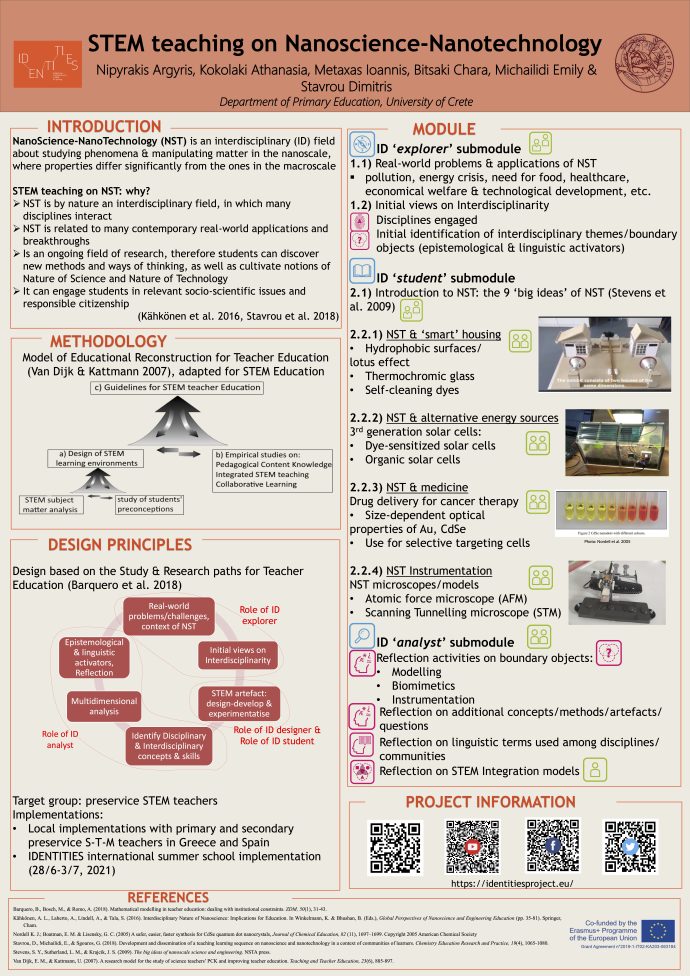Download the module’s lesson plan (pdf, editable format)
The rationale for choosing Nanoscience-Nanotechnology (NST) for STEM teaching relies on the fact that: a) NST is by nature an interdisciplinary field, in which many disciplines interact. According to Kähkönen et al. (2016) “interdisciplinarity is the only thing that gives a name to nanoscience”. In specific, physics, chemistry, biology, material science, medicine, computer science and engineering are some indicative disciplines that are related to NST phenomena. b) NST is related to many contemporary real-world applications, and breakthroughs, c) being an ongoing field of research, it gives the opportunity to students to discover new methods and new ways of thinking as well as to cultivate views of Nature of Science and Nature of Technology, and d) it can engage students in relevant socio-scientific issues and issues of responsible citizenship (Kähkönen et al., 2016; Stavrou et al., 2018).
Moreover, it is a topic that, although it is considered a contemporary advanced STEM topic, several connections with the current curricula can be used as ‘entrance’ points to NST concepts/phenomena/applications, e.g. atomic structure, orbitals, materials’ properties (optical, electrical, etc.), polymers, etc.
The NST module makes use of theoretical frameworks implemented and elaborated during the IDENTITIES project, as follows:
- The module uses informed views on Interdisciplinarity (Klein 2017) both during the design of the module and the activities for the students, contrasting multi-, trans- and a-disciplinarity views.
- The module implements the boundary object framework (Akkerman & Bakker 2011) as a means to explore the interconnections among disciplines. Particularly, the module designers implemented boundary objects such as modelling, instrumentation and biomimicry as ‘lenses’ through which students would be facilitated to identify and analyse the relative disciplines and the interactions among them. Furthermore, it enacts students’ epistemic agency by inviting participating students to reflect and identify additional boundary objects themselves, and also justifying their views.
- The project also implements epistemological activators (Ravaioli, 2020) as boundary objects. In specific, epistemological activators are themes that activate a meta-level of analysis in which the disciplines can be characterised, compared and intertwined. Hence, epistemological activators can assist in the cultivation of interdisciplinary consciousness. Additionally, linguistic activators (Polverini 2022) are terms, syntaxes and lexicons that can be used as another layer of identifying, comparing, and negotiating disciplinary knowledge and skills through the commonalities and differences that they get among the languages of different communities.
- The module implements ‘professional’ questions as a tool to orient students to the educational perspective and applicability of their teaching ideas. In specific, questions are been posed to students regarding the justification of introducing NST to schools, the core NST concepts to be taught, and the affordances and constraints of the transposition of NST knowledge and skills to schools.
Introduction to the IDENTITIES approach to interdisciplinarity
Some videos to learn the basics of the frameworks, terminology, and tools on which the different activities of the module are built!
 Becoming explorers
Becoming explorers
Aims: Contextualisation of NST to real-world problems and challenges that is related to. Significant NST applications and innovations are been introduced to students, whereas space is given to students to mention additional ones from their knowledge and experiences. The students are subsequently called upon to reflect and discuss on the S-T-E-M disciplines engaged in the topics presented, and to preliminary identify boundary objects in the module in terms of concepts/methods/artefacts/questions or linguistic terms.
Activities: After a round of exploration of real-world problems that NST contributes to, the instructor(s) present some main application areas of NST, such as environmental issues, energy crisis, overpopulation and increasing need for food, healthcare and technological development. Subsequently, students work in groups and analyse the topics in the light of the disciplines involved and the boundary objects in terms of epistemological and linguistic activators in which they can identify interactions between disciplines.
Introductory presentation on NST-related real-world problems and applications (pdf, editable format)


Collective discussion on identification of NST-related real-world problems, the disciplines engaged and identification of the initial epistemological and linguistic activators (pdf, editable format)




 Becoming students
Becoming students
Aims: The aim of this submodule is to offer students the opportunity to get informed and to practically experience NST-related activities in some indicative main application areas. These activities act as a reference space in which students will reflect on and perform an interdisciplinary analysis in the analyst submodule.
Activities: Initially, students are introduced to core NST concepts/phenomena/applications (the 9 ‘big ideas’ of NST). Thereafter, students work in groups in 4 sets of activities concerning: a) NST & smart housing, in which students engage with NST applications such as thermochromic glass, waterproof surfaces and self-cleaning dyes. b) NST & alternative energy sources, in which students engage with third-generation solar cells (organic & dye-sensitised dollar cells) and compare them with conventional solar cells. c) NST & Medicine, in which students explore how nanoparticles of different sizes have different energy band gaps and hence can be implemented for selective targeting of cancer cells in the human body. d) NST instrumentation, in which students engage with the main operation principles of instruments use in NST such as the Scanning Tunnelling Microscope (STM) and the Atomic Force Microscope (AFM). At the end of this submodule, time is given to student groups to recap and share their experiences with the other peer groups.
Interactive lecture on core NST concepts, phenomena, and applications (pdf, editable format)





Students explore NST applications concerning “smart” housing (thermochromic glasses & biomimetic applications about waterproofing) (pdf, editable format)





Supplementary material – Thermochromic grass (video)
Supplementary material – Lotus effect (video)
Supplementary material – Hydrophobicity (video)
Supplementary material – Biomimicry (video)
Students explore NST applications concerning 3rd-generation solar cells (pdf, editable format)





Supplementary material – DSSC (video)
Supplementary material – Organic solar cells (Smart greenhouse) (video)
Students explore NST medical applications such as the use of Au nanoparticles for cancer therapy through selective targeting (pdf, editable format)





Supplementary material – Spreadsheet (pdf, editable format)
Students explore NST instrumentation and microscopes (pdf, editable format)





Supplementary material – Surface (video)
Supplementary material – Spreadsheet (pdf, editable format)
 Becoming analysts
Becoming analysts
Aims: Introduction of theoretical frameworks of analysing interdisciplinarity, such as the epistemological and linguistic activators that act as boundary objects in this module. This submodule calls upon students to reflect on the boundary objects implemented by the researchers in the module, but also gives space to students to reflect on additional boundary objects they recognise. At the end of this submodule, students reflect on visual representations of STEM models (Ring et al. 2017) as a reflective epistemological activity on integrated STEM.
Activities: The participants become “interdisciplinarity analysts” since, in groups, carry out a meta-reflection on the previous activity in terms of reflecting on boundary objects introduced by the researchers, which were deemed to be modelling (Develaki 2020), instrumentation (Stevens et al., 2009), and biomimicry (Krohs, 2022). Students also reflect on linguistic terms that have different nuances among communities such as ‘properties’, ‘nanoscale’, ‘efficiency’ and ‘artificial/natural’. Furthermore, students are given the opportunity to identify additional boundary objects themselves and discuss about them. Finally, students are introduced to teacher-generated STEM models (Ring et al. 2017) and are called upon to comment on them, state their preferred STEM model representation, and optionally create and justify their own STEM model representation.
Collective discussion on the epistemological and linguistic activators regarding NST concepts, phenomena, and applications students experienced in the Student block




Worksheet 1 (pdf, editable format)
Presentation – The history of the evolution of the microscopes (pdf, editable format)
Worksheet 2 (pdf, editable format)
Interactive lecture on STEM integration models (pdf, editable format)


Students reflect on STEM integration models (pdf, editable format)


Download the module’s lesson plan (pdf, editable format)

